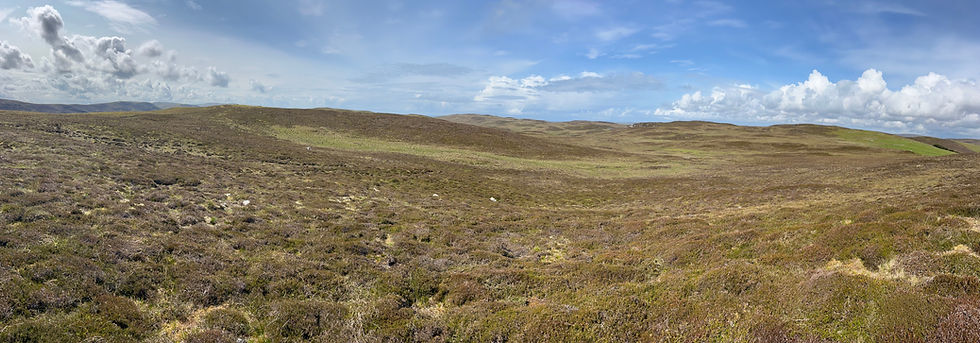In Depth - Steatite in Shetland
- Esther Renwick
- Jan 16, 2016
- 7 min read

The extraction and working of Steatite, or soapstone, has been an important industry throughout much of Shetland’s past. This article provides a brief overview of steatite production on Shetland and is largely drawn from the various papers in the recent Amenity Trust publication, Kleber: Shetland’s Oldest Industry (Turner & Forster 2009).
Steatite has a number of physical properties that make it eminently suited to the production of objects. The high talc content means that it is soft and easily carved, it can be heated and cooled without shattering and it hardens on exposure to air or heat. While exploited since early prehistory the heyday of the steatite industry on Shetland was undoubtedly during the Viking and Norse period. The terms kleber, klever and clammel in Shetland dialect have their origin in Old Norse and leave their mark in Shetland placenames such as Clibberswick and Clammel Knowes on Unst, Clemmil Geo on Fetlar and Cleber Geo in North Mavine (Bray, Forster & Clelland 2009: 4).
The Vikings were not the first to see the potential of Shetland’s steatite. Steatite objects are found on archaeological sites as early as the 4th millennium BC (Forster & Sharman 2009: 27). From this early period it was also being ground down to use as a temper to strengthen pottery (MacSween 2009: 37-38) and by the 3rd millennium BC large steatite vessels were in use. Despite the apparently superior qualities of the steatite, pottery still appears to be the more popular choice for vessels (Forster & Sharman: 29-33). Steatite beads, amulets and armlets have also been found from Bronze Age sites across Shetland.
In these early periods the objects were probably quarried using stone axes, shaped with quartz, antler or bronze points and finished with a coarse and abrasive stone such as sandstone or pumice. Clues to the day to day use of the vessels are found in residues left by their use as cooking pots over open fires. Scouring marks are visible where they were scrubbed out, probably with sand, and holes drilled in broken vessels suggest they were valuable enough to be repaired by being lashed back together and used for dry storage (ibid: 35).
By c.500AD there appears to be a decline in the use of larger steatite vessels which continues throughout the Iron Age (Forster 2009: 48). Steatite is now primarily used for the production of oil lamps, beads and spindle whorls rather than large vessels. A small number of gaming counters and balls were also noted at Old Scatness and Clickimin (ibid: 51-54). Steatite bracelets were recovered from late Bronze Age and Iron Age sites such as Mavis Grind, Jarlshof and Old Scatness and some of these were made from the same dark green shade of stone and appear to have been polished (ibid: 55-56).
The cultural shift that occurs in the islands of the North Atlantic during the 9th and 10th centuries with the arrival and settling of the Vikings brings with it a significant change in material culture as well as language and lifestyle (Forster 2009: 58). At the time of this migration steatite was an important part of Norwegian life having completely replaced pottery by the beginning of the Viking period and probably forming one of its major industries. At the various Shetland Viking excavations the remains of many vessels of various shapes and sizes have been found along with fishing weights, line sinkers, spindle whorls and beads (ibid: 63). Perhaps predictably the Norwegian influence is strong during the early Viking period, c.800-900AD, however there is still evidence for local innovation; for instance, early Viking flat bakeplates found at Old Scatness have no parallel in Scandinavia until around c.1100AD. From c.900-1100 local steatite is increasingly used and the development of four sided vessels in Shetland probably results from adapting to the physical qualities of the local stone. From 1100-1400AD increased contact with Norway is demonstrated by imported bakeplates found in Shetland. From c.950 onwards Shetland itself is exporting considerable quantities of steatite vessels to Orkney and following 1100AD there is also evidence of expanding this export to include Faroe and the Western Isles (ibid: 65-67).
A decrease in steatite vessels and an increase in pottery is seen towards the late Norse period at Jarlshof and at Da Biggins (Papa Stour). It is likely that the introduction of this cheap, imported pottery from the continent during the 14th century led to the decline of the steatite industry. During the post medieval period steatite continued to be used on Shetland for fire bricks and hearth backing, pot-boilers and as a stain remover for woollen clothes (Forster 2009: 68).
The Shetland steatite quarries.
There are twenty three recorded sources of steatite on Shetland, the majority of which are located on Unst followed by Fetlar and North Mavine, with only two sources elsewhere on the Shetland mainland (Bray et al 2009 11-17). There are also nineteen recorded placenames which point to the presence of steatite (Brooke-Freeman 2009: 18-26). Of these sources two have been excavated and are published in the Kleber volume (Turner & Forster 2009): Catpund just to the south of Cunningsburgh and Clibberswick on Unst.
Catpund lies just to the south of Mail, below Cunningsburgh. It was excavated in the 1980s and early 1990s as a rescue excavation due to mineral extraction proposed in the area by the Shetland Talc company seeking industrial grade talc. Over ten tonnes of material was recorded and discarded (worked waste and blanks from quarrying) while another tonne was kept and recorded in more detail. The finds fell into the categories of blocks (a piece of steatite removed from the quarry but not yet formed into a blank), blanks (a block with a rough shape to it ready for finishing into a vessel), round vessels, oval vessels and four sided vessels (Turner, Sharman & Carter 2009: 70-78). The majority of the quarrying appears to date to the Viking and Norse periods and the process takes place in three stages:
initial hollowing out of a blank,
rough hollowing out of the interior,
completed hollowing out of the interior.
The majority of the pieces found were from stage 2, the most hazardous part of the procedure when the block is most likely to break. Although no tools were found at Catpund, chisels, adzes and picks have been found at Scandinavian quarries. Analysis of the tool marks at Catpund suggest the use of a blunt or pointed rather than flat chisel (ibid: 79-80).
There are two interpretations offered for the wide variability between the tool marks and lack of consistency between the various vessels and bakeplates seen at Catpund: either the work was carried out by non-specialists who made their living by quarrying but were not particularly skilled (Sharman 2009: 82-83) or by skilled professionals who were adapting their methods of working to the specific geology and impurities local to each area of the quarry (Turner 2009: 83-84). While it is also debated whether the finer finishing took place on site or elsewhere both authors agree that the small objects (spindle whorls etc) were finished off-site (Turner, Sharman & Carter 2009: 82).
Evidence from another rescue excavation at Clibberswick (once again ahead of proposed mineral extraction in the 1980s) appears to suggest that finishing definitely did not take place on the actual quarry site. However, the sheer weight of the blanks would indicate that it was probably undertaken not far away. Unlike Catpund the chisels used appear to have been of the more standard flat variety as found in Norway and this is probably due to the finer nature of the steatite outcrop. The ad-hoc nature of the quarrying in the excavated area at Clibberswick suggests an opportunistic style of working yet there was evidence of some skill in the handling of the geology (Buttler & Forster 2009: 85-105).
Visiting steatite quarries
There are steatite quarries all over Shetland, the largest and easiest to visit being Catpund located just to the south of Cunningsburgh at National Grid Reference (NGR) HU 4255 2709. Park in the layby, follow the track up past the modern steatite working, take the stile over the fence and follow the fence line until you find the fenced in area with an interpretation board. This is a central part of the quarry but more evidence of quarrying can be seen on outcrops in the immediate vicinity.
For those with more time on their hands another impressive steatite quarry can be seen at Fethaland in North Mavine, NGR HU 3778 9448. Park at Isbister and allow a day for the beautiful circular walk which can be found online here.
As usual when out and about visiting sites, follow the Scottish Access Code, leaving both the countryside and the archaeology the way you found it. Kleber: Shetland’s Oldest Industry (Turner & Forster 2009) can be found in the Lerwick library and lists all the known steatite quarries as well as giving a comprehensive overview of the development of steatite use on Shetland.
References
Bray, I, Forster, A, Clelland, S-J 2009 “Steatite and Shetland: a geological introduction and gazetteer of sites” in in Turner, V & Forster, A (eds) Kleber: Shetland’s Oldest Industry Shetland Amenity Trust
Brooke-Freeman, E 2009 “Locating Shetland Steatite using Placenames” in in Turner, V & Forster, A (eds) Kleber: Shetland’s Oldest Industry Shetland Amenity Trust
Buttler, S and Forster, A 2009 “Excavations at Clibberswick: a report on rescue work at a Norse steatite quarry in Unst, Shetland, July-August 1983” in Turner, V & Forster, A (eds) Kleber: Shetland’s Oldest Industry Shetland Amenity Trust
Forster, A 2009 “Steatite Use in the Middle and Late Iron Age: c.500BC-AD800” in Turner, V & Forster, A (eds) Kleber: Shetland’s Oldest Industry Shetland Amenity Trust
Forster, A 2009 “Viking and Norse Steatite Use in Shetland” in Turner, V & Forster, A (eds) Kleber: Shetland’s Oldest Industry Shetland Amenity Trust
Forster, A and Sharman, P 2009 “Use in Early Prehistoric Shetland: from the Neolithic to the Early Iron Age” in Turner, V & Forster, A (eds) Kleber: Shetland’s Oldest Industry Shetland Amenity Trust
MacSween, A 2009 “A Note on the Use of Steatite as Temper” in Turner, V & Forster, A (eds) Kleber: Shetland’s Oldest Industry Shetland Amenity Trust
Turner, V, Sharman, P and Carter, S 2009 “Excavations at Catpund, Cunningsburgh” in Turner, V & Forster, A (eds) Kleber: Shetland’s Oldest IndustryShetland Amenity Trust
Some Photographs by Kind Permission of Shetland Museum and Archives

















Comments